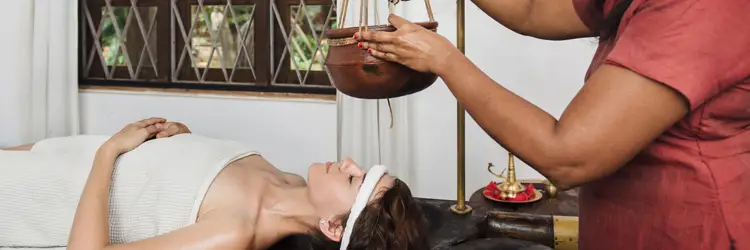+91 9895734005
Call us anytime
info@idealkerala.com
Drop us a line anytime!
+91 9895734005
Call us anytime
info@idealkerala.com
Drop us a line anytime!
In Ayurveda, the human body is controlled by three vital energies known as the Ayurveda doshas which are Vata, Pitta, and Kapha. These three doshas in Ayurveda represent a unique combination of the five elements (earth, water, fire, air, and space) and influence our physical, mental, and emotional health. Understanding your Ayurveda 3 doshas helps in maintaining balance and choosing the right lifestyle, diet, and treatments for holistic well-being.
Proper balance among these three Doshas is essential for good health. Vata Dosha is composed of Akasa (ether) and Vayu (air) Mahabhutas. Pitta Dosha is composed of Tejas or Agni (fire) and Ap Mahabhutas. Kapha Dosha is composed of Ap (water) and Prithvi (earth) Mahabhutas.
In Ayurveda, every person has a unique mind-body treatment known as a dosha. The three primary doshas Vata, Pitta, and Kapha have different physical and mental characteristics. Below is a quick comparison of the three dosha Ayurvedic body types.
| Aspect | Vata Dosha (Space & Air) | Pitta Dosha (Fire & Water) | Kapha Dosha (Earth & Water) |
|---|---|---|---|
| Elemental Basis | Ether (Space) + Air | Fire + Water | Earth + Water |
| Key Function | Controls movement | Regulates metabolism | Maintains structure and stability |
| Personality Traits | Creative, quick-thinking, cheerful | Intelligent, focused, confident | Calm, patient, emotionally stable |
| Emotional Tendencies | Imaginative, anxious, restless | Passionate, impatient, easily angered | Loving, attached, sometimes stubborn |
| Body Type | Slim with weight fluctuations | Medium build with good muscle tone | Strong, heavier body build |
| Skin | Dry, prone to fine lines | Sensitive, acne-prone | Oily, smooth, well-hydrated |
| Hair | Thin, fine hair | Fine hair, early greying possible | Thick, strong, lustrous hair |
| When Imbalanced | Anxiety, digestive issues, restlessness | Inflammation, overheating, irritability | Weight gain, lethargy, congestion |
Tip: To accurately find your dosha Ayurveda style, it's best to consult with an experienced Ayurvedic ractitioner. They check your physical traits, emotional tendencies, and health history to determine your ominant dosha.

To determine your dominant dosha, you can consult with an Ayurvedic practitioner
Balancing your dosha involves making lifestyle choices that balance with your correct energy. Here are some general guidelines for Ayurveda Vata dosha, Ayurveda Pitta dosha, and Kapha dosha::
| Vata Dosha | ||
|---|---|---|
| Vata Management | To Eat | To Avoid |
|
|
|
| Pitta Dosha | ||
|---|---|---|
| Pitta Management | To Eat | To Avoid |
|
|
|
| Kapha Dosha | ||
|---|---|---|
| Kapha Management | To Eat | To Avoid |
|
|
|
Individuals with a Pitta-Kapha personality type are those who exhibit characteristics of both Pitta and Kapha doshas. They may experience a balance of assertiveness and calmness, but they should be cautious about potential imbalances that could lead to challenges like weight gain and digestive issues. A combined strategy of Ayurvedic treatment for Pitta dosha and Kapha management helps restore balance.
Understanding and balancing the Ayurveda doshas is the main part of well-being in Ayurvedic science. Whether you are looking for Ayurvedic treatment for Pitta dosha, Vata dosha treatment in Ayurveda, or guidance on a personalized Ayurvedic diet for Pitta dosha, balancing your lifestyle with your body type can lead to a healthier, more harmonious life. For best results, always seek professional advice to identify and find your dosha Ayurveda-wise, and begin your journey toward balancing doshas in Ayurveda naturally.
You can find your dosha in Ayurveda by consulting an Ayurvedic practitioner or taking a detailed dosha quiz that checks your physical, emotional, and mental conditions.
The three doshas in Ayurveda are Vata (air + space), Pitta (fire + water), and Kapha (earth + water). Each person has a unique combination of these doshas, known as the Ayurveda 3 doshas.
Vata dosha in Ayurveda is made up of air and ether elements. It controls movement, communication, and circulation in the body. People with primary Vata are often energetic but may face dryness, anxiety, or restlessness.
To reduce Pitta dosha in Ayurveda, follow a cooling diet, avoid spicy and oily foods, practice calming activities like yoga, and stay in cool environments. Ayurvedic treatment for Pitta dosha includes herbs, meditation, and lifestyle changes.
Kapha is usually considered the most common dosha, but this changes based on region and lifestyle. Many people also have dual dosha types, such as Vata-Pitta or Pitta-Kapha.
A Pitta person is typically intelligent, confident, and driven. Physically, they may have a medium build, warm body temperature, and sensitive skin. When imbalanced, Pitta types may experience anger, acne, or inflammation.
A Vata-Pitta person shows conditions of both doshas, creative, active, sharp-minded, and passionate. They should focus on grounding routines and cooling practices to maintain balance.
Dosha imbalances show up as symptoms like dry skin (Vata), inflammation (Pitta), or weight gain (Kapha). An Ayurvedic consultation helps find your dosha imbalance and guide treatment.
Balanced Pitta leads to strong digestion, sharp intellect, and healthy skin. Signs of Pitta dosha balance include calmness, clear skin, and strong energy without overheating or irritability.
No dosha is “bad” in Ayurveda. But, an imbalance in any dosha can cause health issues. Maintaining Vata, Pitta, and Kapha in balance for proper health and well-being.